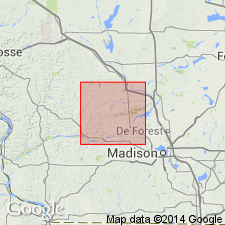
- Usage in publication:
-
- Black Earth Member
- Modifications:
-
- Overview
- Dominant lithology:
-
- Siltstone
- Dolomite
- Sand
- AAPG geologic province:
-
- Wisconsin arch
Summary:
At this time, St. Lawrence Formation, which is about 10 m thick in the study area, is considered to have just two subdivisions: the lower Black Earth Member (dolomite) and the upper Lodi Member (siltstone). St. Lawrence has previously been lumped with part or all of the overlying Jordan Sandstone and referred to the Trempealeau Group. Term Trempealeau is no longer used in WI in a lithostratigraphic sense. Black Earth is apparently absent in some northern parts of the county and thickens to no more than a few meters in the southern part. Interfingers with Lodi Member. Dolomite of the Black Earth contains varying amounts of quartzose and glauconitic silt and very fine sand. Commonly gray or brown with purple stains. Lodi Member makes up the bulk of the St. Lawrence. St. Lawrence overlies Lone Rock and Mazomanie Members of Tunnel City Formation.
Source: GNU records (USGS DDS-6; Reston GNULEX).
For more information, please contact Nancy Stamm, Geologic Names Committee Secretary.
Asterisk (*) indicates published by U.S. Geological Survey authors.
"No current usage" (†) implies that a name has been abandoned or has fallen into disuse. Former usage and, if known, replacement name given in parentheses ( ).
Slash (/) indicates name conflicts with nomenclatural guidelines (CSN, 1933; ACSN, 1961, 1970; NACSN, 1983, 2005, 2021). May be explained within brackets ([ ]).

